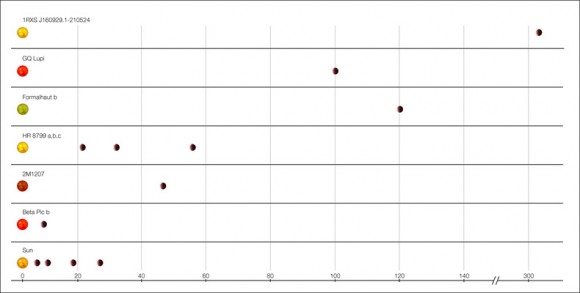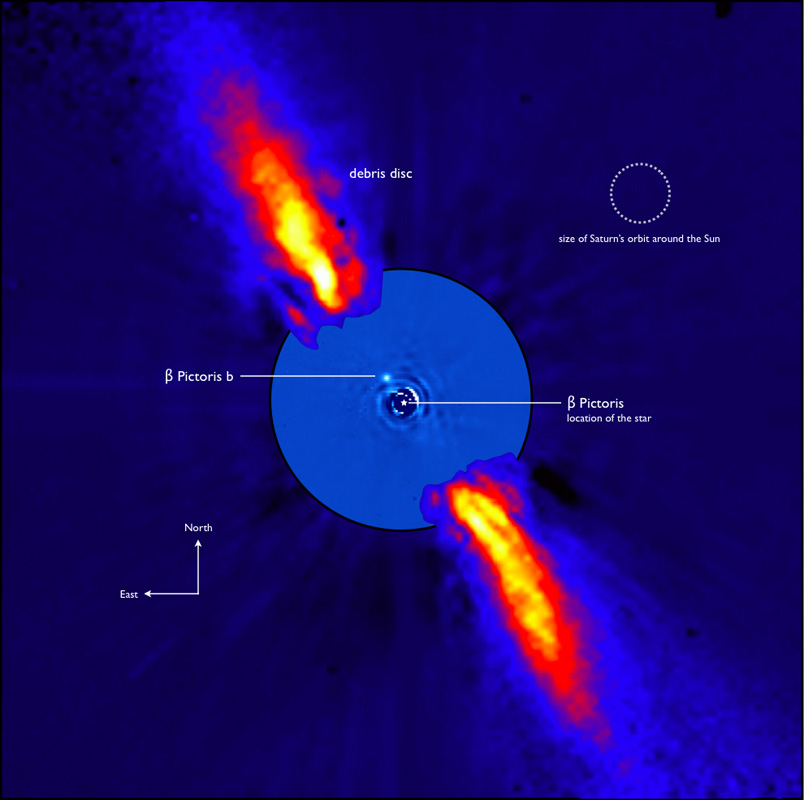[/caption]
Have the floodgates opened for imaging exoplanets?! A team of French astronomers using ESO’s Very Large Telescope have discovered an object located very close to the star Beta Pictoris. This object lies only 8 times the Earth-Sun distance, and it’s likely a giant planet that astronomers suspected was there from the peculiar shape of the disc that surrounds the star. If the object is actually a planet, this would then be the first image of a planet that is as close to its host star as Saturn is to the Sun. This comes on the heels of the news of two of the first direct images ever of exoplanets just last week (see here and here).
Only 12 million years old, the ‘baby star’ Beta Pictoris is located about 70 light-years away towards the constellation Pictor (the Painter). The above image is an infrared image, and visible is the dusty debris disk surrounding the star Beta Pictoris. Debris discs are composed of dust resulting from collisions among larger bodies like planetary embryos or asteroids, and they are a bigger version of the zodiacal dust in our Solar System. Its disc was the first to be imaged — as early as 1984 — and remains the best-studied system. Earlier observations showed a warp of the disc, a secondary inclined disc and infalling comets onto the star. “These are indirect, but tell-tale signs that strongly suggest the presence of a massive planet lying between 5 and 10 times the mean Earth-Sun distance from its host star,” says team leader Anne-Marie Lagrange. “However, probing the very inner region of the disc, so close to the glowing star, is a most challenging task.”
Using an adaptive optics system in infrared wavelengths attached to the VLT, the astronomers were able to discern a feeble, point-like glow well inside the star’s halo. To eliminate the possibility that this was an artifact and not a real object, a battery of tests was conducted and several members of the team, using three different methods, did the analysis independently, always with the same success. Moreover, the companion was also discovered in other data sets, further strengthening the team’s conclusion: the companion is real.
“Our observations point to the presence of a giant planet, about 8 times as massive as Jupiter and with a projected distance from its star of about 8 times the Earth-Sun distance, which is about the distance of Saturn in our Solar System,” says Lagrange.
“We cannot yet rule out definitively, however, that the candidate companion could be a foreground or background object,” cautions co-worker Gael Chauvin. “To eliminate this very small possibility, we will need to make new observations that confirm the nature of the discovery.”
The fact that the candidate companion lies in the plane of the disc also strongly implies that it is bound to the star and its proto-planetary disc.
“Moreover, the candidate companion has exactly the mass and distance from its host star needed to explain all the disc’s properties. This is clearly another nail in the coffin of the false alarm hypothesis,” adds Lagrange.

When confirmed, this candidate companion will be the closest planet from its star ever imaged. In particular, it will be located well inside the orbits of the outer planets of the Solar System. Several other planetary candidates have indeed been imaged, but they are all located further away from their host star: if located in the Solar System, they would lie close or beyond the orbit of the farthest planet, Neptune. The formation processes of these distant planets are likely to be quite different from those in our Solar System and in Beta Pictoris.
“Direct imaging of extrasolar planets is necessary to test the various models of formation and evolution of planetary systems. But such observations are only beginning. Limited today to giant planets around young stars, they will in the future extend to the detection of cooler and older planets, with the forthcoming instruments on the VLT and on the next generation of optical telescopes,” concludes team member Daniel Rouan.
For a list of candidate exoplanets directly imaged, see this link.
Source: ESO


Wow, this is awesome. When it rains, it pours.
Could the exact instrument be named? Was it NACO or SINFONI??
Too cool.
Now get the spectroscopy equipment tweeked up and detect some oxygen in the atmosphere.
I’m assuming by the chart that we have accepted the images of the other planets (besides the four planets imaged last week) to be verified?
@ bse5150
In that chart only the first object 2M1207 has a mass which is less than 13 Jupiter mass, which is the brown dwarf – planet limit. All the others are above this limit and hence still a bit controversial…
For more info plz refer http://www.exoplanet.eu
@ Don Alexander, according to the ESO press release (http://www.eso.org/public/outreach/press-rel/pr-2008/pr-42-08.html) the observations were made with the NACO AO camera on the 8.2m VLT Yepun (UT4) telescope at the VLT. The press release also links to a short, 5 page paper of the discovery(http://www.eso.org/public/outreach/press-rel/pr-2008/betapic.pdf) submitted to Astronomy & Astrophysics 11-21-08 with salient details of the discovery (and many fascinating pix) included. Indeed, a remarkable time to be witness to these first direct-imaging observations of extrasolar planets.
Cautionary note for those of you who might not be used to looking at highly processed images: the circle you can see the planet sitting on is very likely an artifact. The plan of the planet’s orbit is probably the same as the debris cloud, in which case we are seeing the orbit pretty near end-on, hence the large errors in the estimates of the radius.
If it really is at Saturn’s orbit, then we ought to see the thing move. I don’t have any figures for the mass of Beta Pictoris, but Saturn takes 30 years to go around the sun, so expect more news in six months or so.
…just a few (thousand or million) more steps to a more conventional visible light image!
I realize that it’s a long way off, but we’re making progress…